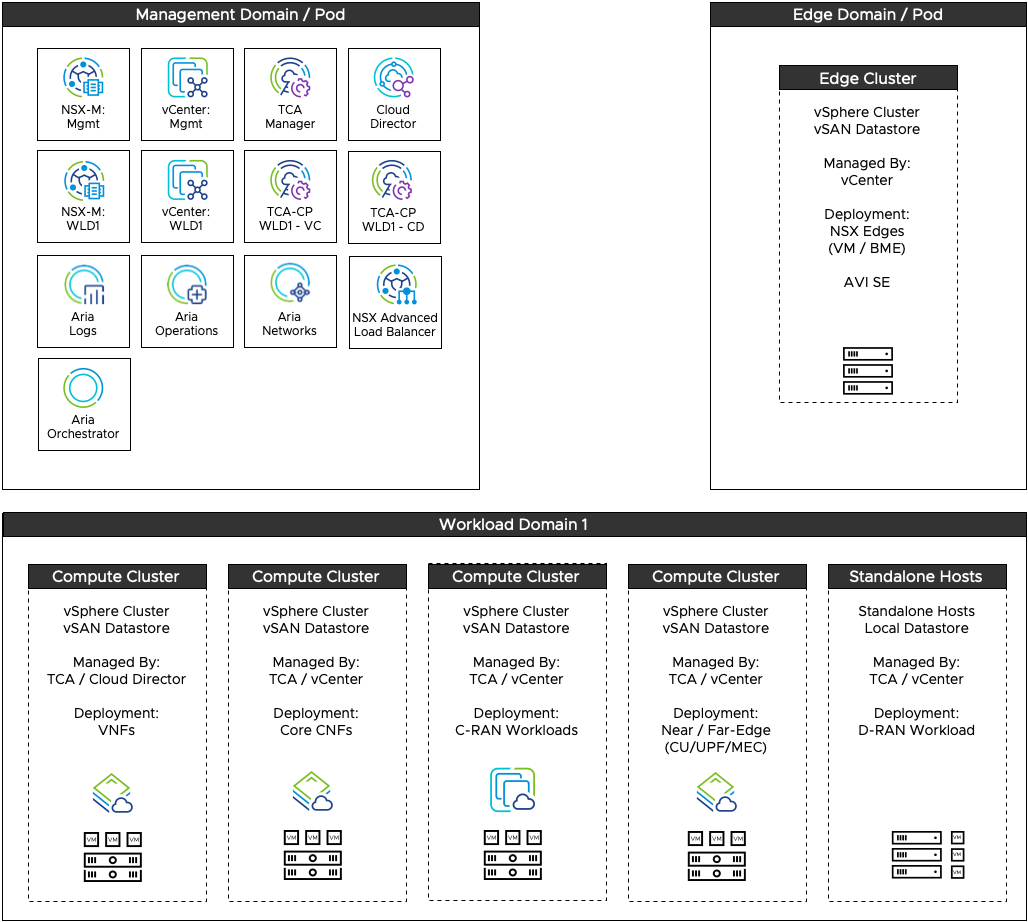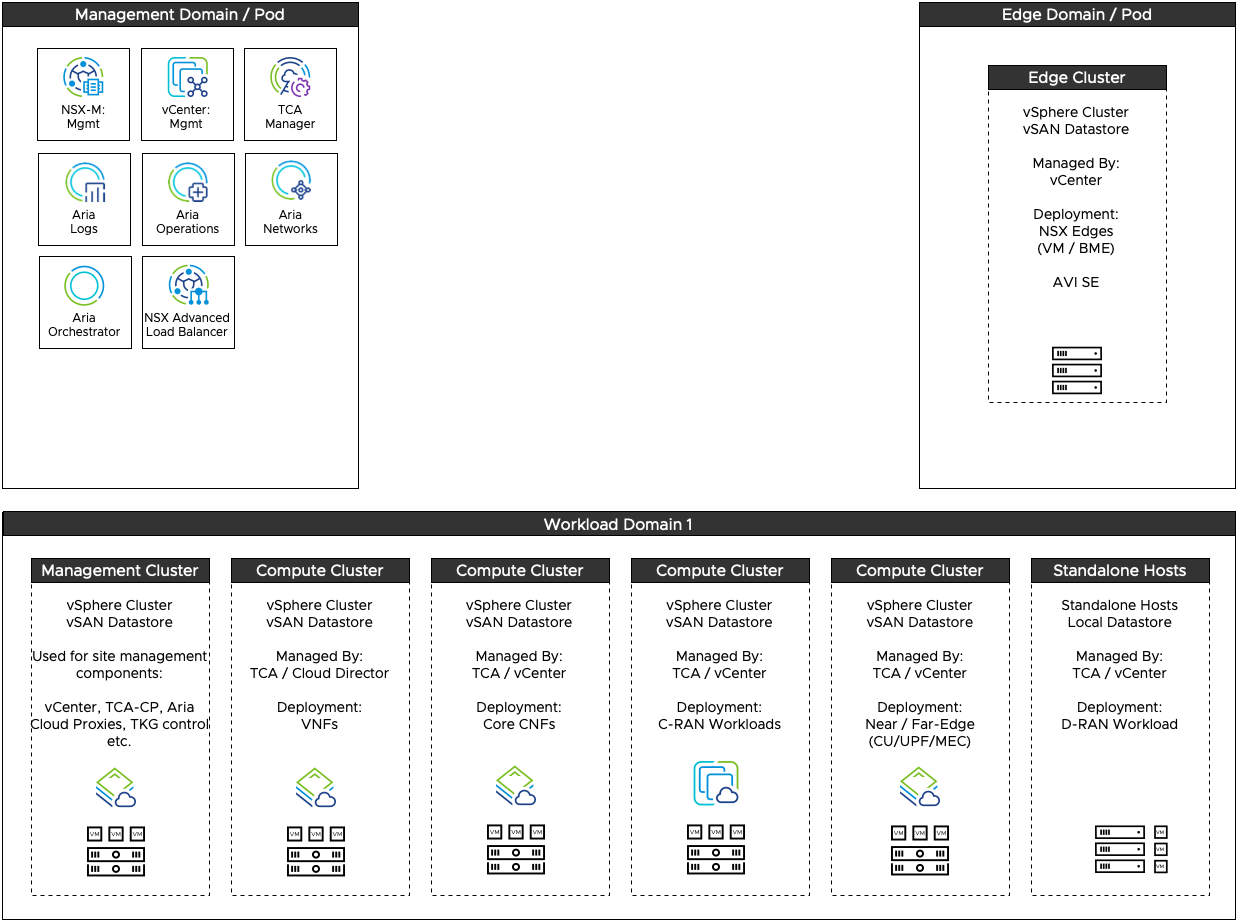This section describes the end-to-end deployment architecture of the Telco Cloud Platform, covering both centralized and multi-site designs. These deployment models encompass IaaS services for 4G/5G VNFs as well as 5G Core and RAN CNFs.
Centralized Deployment Model
In the Centralized deployment model, the Telco Cloud is divided into various domains. Each domain serves a specific purpose to the applications running on the Telco Cloud.
The Management pod / domain hosts all the components necessary for the instantiation and operation of the Telco Cloud. Each workload domain hosts one or more compute environments that allow the placement of workloads such as 4G VNFs, 5G Core and RAN CNFs.
Depending on the overall use case and design requirements of the Telco Cloud, the Management domain components vary for each Telco Cloud deployment. For example, a RAN-only deployment does not require components such as NSX and VMware Cloud Director.

In the management domain, a single vCenter manages each workload domain. The expansion of workload domains requires additional vCenter Servers and TCA-CP nodes.
A single management domain is deployed in the main data center (central data center). It can stretch across multiple data centers in an active-active or active-standby configuration leveraging the BCDR solution for management domain failover.
The telco cloud architecture can be scaled out and scaled up across the cloud, within a specific workload domain or across multiple workload domains.
The telco cloud can be scaled out by adding more workload domains with new vCenter Server, Telco Cloud Control Plane, and NSX deployments.
Note:When adding more workload domains, the Management domain may require additional resources for new vCenter, NSX, and NSX Advanced Load Balancer deployments.
A single workload domain can be scaled up by adding more compute clusters to be consumed by VMware Cloud Director, VMware Integrated OpenStack, or Telco Cloud Automation, and by adding more cell sites (standalone hosts) for RAN deployments.
Multi-Site Deployment Model
The multi-site deployment model of the telco cloud platform provides a distributed approach to the management pod such that the components can be distributed throughout the network. The central management domain can host the main components of the Telco Cloud. A localized, smaller management domain can be added to each site for independent site management.

The following components can be deployed in a localized management cluster within a distributed environment:
Local vCenter to manage the site resources
Local NSX Advanced Load Balancer to manage site networking
Local Telco Cloud Automation-Control Plane for site control
Local Aria Operations Cloud Proxies for remote data collection and forwarding to the central management domain
Local Aria Operations for Logs collectors for remote log collection and forwarding to the central management domain
Additional components can be deployed in the localized management domain based on the requirements for function distribution and locality of management.
In both the centralized and multi-site deployment designs, it is not necessary to have all workloads on a single site. A workload domain can host multiple compute clusters or RAN nodes from multiple physical locations. The multi-site design applies the concept of workload distribution across multiple DCs to the management components as well.
The characteristics of a management domain in an end-to-end deployment architecture:
Each workload domain has its own vCenter hosted on the centralized or multi-site management domain.
Each workload domain has one or more TCA-CPs hosted on the centralized or multi-site management domain.
Each workload domain has its own NSX manager, if required. NSX is not required for a RAN workload only domain.
The VIM options must not share a single cluster. Separate clusters are recommended for VNFs, CNFs, or RAN workloads. Sharing a single cluster across multiple VIMs is not recommended.
Different vSphere switches can be created for different clusters. The vSwitch architecture for RAN sites uses a different vSwitch design for 5G Core and VNF based clusters.
When using Tanzu Kubernetes Grid, deploy the control-plane nodes in the workload cluster. Alternately, the control-plane nodes can be deployed in a separate cluster that is part of the same vCenter.
A workload domain does not have to host all cluster types. Depending on the requirements, a workload domain may consist entirely of standalone hosts for RAN workloads (along with a near/far edge cluster for storing the control plane nodes) or the workload domain may consist of vSphere clusters for legacy VNF placement through Cloud Director.